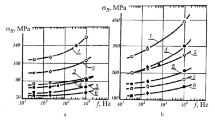Abstract
Investigations were carried out into the dependence of the accuracy of estimates of the distribution parameters of the endurance limit on methodological special features of carrying out fatigue tests by the method of stepped load variation. The effect of the number of specimens, the increase of the load levels, and also of the sequence of testing the specimens on the accuracy of estimates of the examined parameters is shown. Recommendations are made for determining the basic estimates of the distribution parameters of the endurance limits by the method of stepped load variation.
Similar content being viewed by others
Literature cited
V. I. Trufyakov, Fatigue of Welded Joints [in Russian], Naukova Dumka, Kiev (1973).
V. T. Troshchenko and L. A. Sosnovskii, Fatigue Resistance of Metals and Alloys, A Handbook [in Russian], Vol. 1, Naukova Dumka, Kiev (1987).
V. M. Grebennik and V. K. Tsapko, Reliability of Metallurgical Equipment [in Russian], Metallurgiya, Moscow (1980).
N. V. Oleinik and S. T. Sklyar, Accelerated Fatigue Tests [in Russian], Naukova Dumka, Kiev (1985).
A. P. Korobovich, A Method of Determining Calculated Fatigue Resistances of Welded Joints from the Results of Tests in the Region Fatigue Strength for Finite Endurance, Author's Abstract of Dissertation for the Title of the Candidate of Technical Sciences, Kiev (1986).
P. Rabbe, “Application of statistical methods to fatigue research,” Rev. Francaise Mech., No. 37, 37–46 (1971).
Strength Calculations and Tests in Engineering. Mechanical Testing Methods. Planning of Mechanical Tests and Statistical Processing of the Results: Procedure Instructions RD50-398 [in Russian], Publishing House of Standards, Moscow (1984).
M. N. Stepnov, Statistical Methods of Processing the Results of Mechanical Tests, A Handbook [in Russian], Mashinostroenie, Moscow (1985).
V. P. Kogaev, Strength Calculations at Stresses Variable with Time [in Russian], Mashinostroenie, Moscow (1977).
W. Weibull, Fatigue Tests and Analysis of Their Results [Russian translation], Mashinostroenie, Moscow (1964).
O. Yu. Kramarenko, “Evaluation of scatter with respect to stresses in fatigue testing (Review),” Zavod. Lab., No. 6, 711–716 (1962).
M. I. Plyuksne and V. T. Goncharov, “Problem of accelerated determination of the endurance limit and the multiaxial strain,” Zavod. Lab., No. 9, 1122–1123 (1967).
B. V. Bortsov, Reliability of the Aircraft Frame [in Russian], Mashinostroenie, Moscow (1976).
L. M. Shkol'nik, Fatigue Testing Procedures, A Handbook [in Russian], Metallurgiya, Moscow (1978).
V. I. Dvoretskii and A. P. Korobovich, “Accuracy of estimating the distribution parameters of the endurance limits by ladder method,” Inform. Mater. Sev, No. 1 (23), 23–35 (1983).
V. I. Dvoretskii and A. P. Korobovich, “Dependence of the endurance of rolled sheets on the fatigue failure criteria,” Probl. Prochn., No. 12, 24–27 (1989).
Author information
Authors and Affiliations
Additional information
Translated from Problemy Prochnosti, No. 7, pp. 57–61, July, 1991.
Rights and permissions
About this article
Cite this article
Dvoretskii, V.I., Korobovich, A.P. Accuracy of evaluating the fatigue resistance characteristics by the method of stepped load variation. Strength Mater 23, 782–787 (1991). https://doi.org/10.1007/BF00771282
Received:
Issue Date:
DOI: https://doi.org/10.1007/BF00771282



